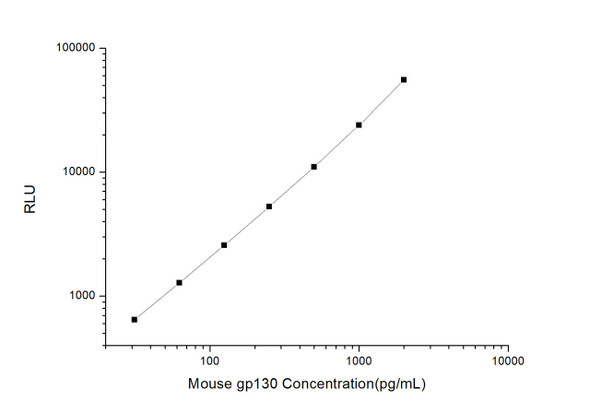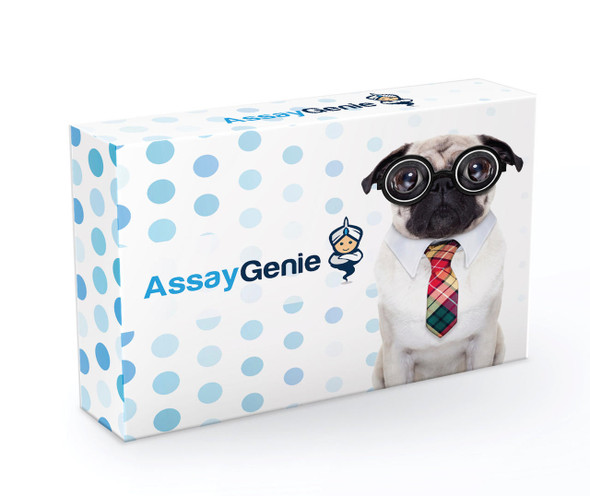Rat Signaling ELISA Kits 3
Rat gp130 (Glucoprotein 130) CLIA Kit (RTES00243)
- SKU:
- RTES00243
- Product Type:
- ELISA Kit
- ELISA Type:
- CLIA Kit
- Size:
- 96 Assays
- Sensitivity:
- 18.75pg/mL
- Range:
- 31.25-2000pg/mL
- ELISA Type:
- Sandwich
- Synonyms:
- IL6ST, CD130, CDW130, IL-6RB, IR6RB, Interleukin 6 signal transducer
- Reactivity:
- Rat
- Sample Type:
- Serum, plasma and other biological fluids
Description
| Assay type: | Sandwich |
| Format: | 96T |
| Assay time: | 4.5h |
| Reactivity: | Rat |
| Detection method: | Chemiluminescence |
| Detection range: | 31.25-2000 pg/mL |
| Sensitivity: | 18.75 pg/mL |
| Sample volume: | 100µL |
| Sample type: | Serum, plasma and other biological fluids |
| Repeatability: | CV < 15% |
| Specificity: | This kit recognizes Rat gp130 in samples. No significant cross-reactivity or interference between Rat gp130 and analogues was observed. |
This kit uses Sandwich-CLIA as the method. The micro CLIA plate provided in this kit has been pre-coated with an antibody specific to Rat gp130. Standards or samples are added to the appropriate micro CLIA plate wells and combined with the specific antibody. Then a biotinylated detection antibody specific for Rat gp130 and Avidin-Horseradish Peroxidase (HRP) conjugate are added to each micro plate well successively and incubated. Free components are washed away. The substrate solution is added to each well. Only those wells that contain Rat gp130, biotinylated detection antibody and Avidin-HRP conjugate will appear fluorescence. The Relative light unit (RLU) value is measured spectrophotometrically by the Chemiluminescence immunoassay analyzer. The RLU value is positively associated with the concentration of Rat gp130. The concentration of Rat gp130 in the samples can be calculated by comparing the RLU of the samples to the standard curve.
| UniProt Protein Function: | Signal-transducing molecule. The receptor systems for IL6, LIF, OSM, CNTF, IL11, CTF1 and BSF3 can utilize IL6ST for initiating signal transmission. Binding of IL6 to IL6R induces IL6ST homodimerization and formation of a high-affinity receptor complex, which activates Janus kinases. That causes phosphorylation of IL6ST tyrosine residues which in turn activates STAT3. Mediates signals which regulate immune response, hematopoiesis, pain control and bone metabolism. Has a role in embryonic development. Does not bind IL6. Essential for survival of motor and sensory neurons and for differentiation of astrocytes. Required for expression of TRPA1 in nociceptive neurons. Required for the maintenance of PTH1R expression in the osteoblast lineage and for the stimulation of PTH-induced osteoblast differentiation. Required for normal trabecular bone mass and cortical bone composition. |
| NCBI Summary: | IL-6 signal transducing molecule [RGD, Feb 2006] |
| UniProt Code: | P40190 |
| NCBI GenInfo Identifier: | 729835 |
| NCBI Gene ID: | 25205 |
| NCBI Accession: | P40190. 1 |
| UniProt Related Accession: | P40190 |
| Molecular Weight: | 102,450 Da |
| NCBI Full Name: | Interleukin-6 receptor subunit beta |
| NCBI Synonym Full Names: | interleukin 6 signal transducer |
| NCBI Official Symbol: | Il6st |
| NCBI Official Synonym Symbols: | Gp130; Ac1055; Il-6rb |
| NCBI Protein Information: | interleukin-6 receptor subunit beta |
| UniProt Protein Name: | Interleukin-6 receptor subunit beta |
| UniProt Synonym Protein Names: | Interleukin-6 signal transducer; Membrane glycoprotein 130; gp130; Oncostatin-M receptor subunit alpha; CD_antigen: CD130 |
| Protein Family: | Interleukin-6 receptor |
| UniProt Gene Name: | Il6st |
| UniProt Entry Name: | IL6RB_RAT |
As the RLU values of the standard curve may vary according to the conditions of the actual assay performance (e. g. operator, pipetting technique, washing technique or temperature effects), the operator should establish a standard curve for each test. Typical standard curve and data is provided below for reference only.
| Concentration (pg/mL) | RLU | Average | Corrected |
| 2000 | 52694 58748 | 55721 | 55693 |
| 1000 | 23778 24170 | 23974 | 23946 |
| 500 | 11283 10781 | 11032 | 11004 |
| 250 | 4845 5743 | 5294 | 5266 |
| 125 | 2792 2424 | 2608 | 2580 |
| 62.5 | 1393 1229 | 1311 | 1283 |
| 31.25 | 627 721 | 674 | 646 |
| 0 | 27 29 | 28 | -- |
Precision
Intra-assay Precision (Precision within an assay): 3 samples with low, mid range and high level Rat gp130 were tested 20 times on one plate, respectively.
Inter-assay Precision (Precision between assays): 3 samples with low, mid range and high level Rat gp130 were tested on 3 different plates, 20 replicates in each plate.
| Intra-assay Precision | Inter-assay Precision | |||||
| Sample | 1 | 2 | 3 | 1 | 2 | 3 |
| n | 20 | 20 | 20 | 20 | 20 | 20 |
| Mean (pg/mL) | 96.39 | 167.15 | 827.90 | 90.02 | 165.98 | 851.92 |
| Standard deviation | 11.59 | 13.14 | 80.72 | 8.26 | 16.50 | 82.55 |
| C V (%) | 12.02 | 7.86 | 9.75 | 9.18 | 9.94 | 9.69 |
Recovery
The recovery of Rat gp130 spiked at three different levels in samples throughout the range of the assay was evaluated in various matrices.
| Sample Type | Range (%) | Average Recovery (%) |
| Serum (n=5) | 88-101 | 95 |
| EDTA plasma (n=5) | 99-112 | 106 |
| Cell culture media (n=5) | 102-114 | 107 |
Linearity
Samples were spiked with high concentrations of Rat gp130 and diluted with Reference Standard & Sample Diluent to produce samples with values within the range of the assay.
| Serum (n=5) | EDTA plasma (n=5) | Cell culture media (n=5) | ||
| 1:2 | Range (%) | 85-97 | 92-106 | 101-119 |
| Average (%) | 91 | 97 | 108 | |
| 1:4 | Range (%) | 84-95 | 88-100 | 91-106 |
| Average (%) | 90 | 95 | 97 | |
| 1:8 | Range (%) | 90-101 | 98-115 | 101-117 |
| Average (%) | 95 | 105 | 108 | |
| 1:16 | Range (%) | 97-112 | 93-108 | 91-103 |
| Average (%) | 104 | 99 | 96 |
An unopened kit can be stored at 4°C for 1 month. If the kit is not used within 1 month, store the items separately according to the following conditions once the kit is received.
| Item | Specifications | Storage |
| Micro CLIA Plate(Dismountable) | 8 wells ×12 strips | -20°C, 6 months |
| Reference Standard | 2 vials | |
| Concentrated Biotinylated Detection Ab (100×) | 1 vial, 120 µL | |
| Concentrated HRP Conjugate (100×) | 1 vial, 120 µL | -20°C(shading light), 6 months |
| Reference Standard & Sample Diluent | 1 vial, 20 mL | 4°C, 6 months |
| Biotinylated Detection Ab Diluent | 1 vial, 14 mL | |
| HRP Conjugate Diluent | 1 vial, 14 mL | |
| Concentrated Wash Buffer (25×) | 1 vial, 30 mL | |
| Substrate Reagent A | 1 vial, 5 mL | 4°C (shading light) |
| Substrate Reagent B | 1 vial, 5 mL | 4°C (shading light) |
| Plate Sealer | 5 pieces | |
| Product Description | 1 copy | |
| Certificate of Analysis | 1 copy |
- Set standard, test sample and control (zero) wells on the pre-coated plate and record theirpositions. It is recommended to measure each standard and sample in duplicate. Note: addall solutions to the bottom of the plate wells while avoiding contact with the well walls. Ensuresolutions do not foam when adding to the wells.
- Aliquot 100µl of standard solutions into the standard wells.
- Add 100µl of Sample / Standard dilution buffer into the control (zero) well.
- Add 100µl of properly diluted sample (serum, plasma, tissue homogenates and otherbiological fluids. ) into test sample wells.
- Cover the plate with the sealer provided in the kit and incubate for 90 min at 37°C.
- Aspirate the liquid from each well, do not wash. Immediately add 100µL of BiotinylatedDetection Ab working solution to each well. Cover the plate with a plate seal and gently mix. Incubate for 1 hour at 37°C.
- Aspirate or decant the solution from the plate and add 350µL of wash buffer to each welland incubate for 1-2 minutes at room temperature. Aspirate the solution from each well andclap the plate on absorbent filter paper to dry. Repeat this process 3 times. Note: a microplatewasher can be used in this step and other wash steps.
- Add 100µL of HRP Conjugate working solution to each well. Cover with a plate seal andincubate for 30 min at 37°C.
- Aspirate or decant the solution from each well. Repeat the wash process for five times asconducted in step 7.
- Add 100µL of Substrate mixture solution to each well. Cover with a new plate seal andincubate for no more than 5 min at 37°C. Protect the plate from light.
- Determine the RLU value of each well immediately.






